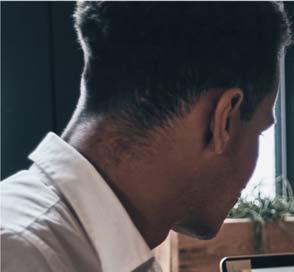
13 minute read
Family Business

With David Pring
Advertisement
Welcome


Welcome to KPMG Family Business feature articles. If you would like to discuss these articles or how KPMG can help with your business please feel free to contact me on 9455 9996 or davidpring@kpmg.com.au


Backbone of economy, mid-market businesses, set to BOUNCE BACK





KRISTINA KIPPER
AT last there seems to be light at the end of the tunnel. As the lockdown restrictions ease, there is a palpable, though still cautious, mood of optimism starting to stir.
In a KPMG survey of 225 mid-market businesses published today, almost 80 percent expressed confi dence in their ability to bounce back from the COVID-19 crisis. Perhaps surprisingly, the majority felt they could be back up to full speed within just 3 months of the pandemic ending.
It shouldn’t be underestimated how widespread the eff ects of the crisis have been. Th e survey, carried out last month, found 86 percent of business leaders had been emotionally concerned at a personal level. Ninety four percent said the crisis had impacted their business – 52 percent of them ‘signifi cantly’.
Th e shutdown has taken a toll, and the economic environment was overwhelmingly (79 percent) the biggest challenge for respondents, followed by other fi nancial issues such as decreased consumer confi dence (48 percent), cost base increases and reduced profi tability (43 percent).
But it would have been much, much worse without the JobKeeper support package. Business leaders, especially in the smaller end of the market, made that very clear.
While nearly 60 percent of businesses categorised themselves as still in the early response or ‘managing through the crisis’ phase, almost one-third were now fully in recovery mode, resett ing and identifying market opportunities. And with each week that passes, more are moving into recovery.
Businesses are now adapting to the new world. It is clear, that in important ways, the lockdown has accelerated necessary changes. Th e obvious one is technology, where there had been a long-term need for upgrades in much of the smaller and mid-tier sector. Th is has now been forced on many organisations to cope with their staff being at home and business activity moving online. Th ere have been increased moves to the cloud and provision of digital models for clients.
Increased workforce engagement has also been a feature of the shutdown. A sizeable number of businesses mentioned this – and workforce capability – as being concerns, given that many now felt under-resourced in the HR function, but we have seen leaders rising to the challenge and in many smaller businesses taking a personal role in the pastoral care of employees.
Th e need for enhanced employee wellbeing will be an ongoing legacy of the crisis – as will customer communication which many companies have had to step up. Not before time in many cases.
Looking ahead, we will see increased fi nancial stress-testing and risk re-assessments; and moves to transform both business models and internal culture. Some of the changes will be permanent.
We can see early signs of a ‘refusal to return’ to the old ways of doing things. Th e obvious example is workforce and travel. Working at home will become a norm for many and there will be longterm implications for industries with decentralised workforces.
Th ere is also a feeling of ‘power in the collective’ – franchisees told us of the benefi ts of being in a larger organisation during the crisis and noted a spike in queries from sole traders.
Th ere are a variety of challenges now facing the mid-tier sector as we start to emerge from the lockdown, but the overriding feeling shown by the report is one of cautious optimism.
Most businesses feel they will either grow, or if business performance is shift - ing, then the negatives will be outweighed by the growth in the next three-month period. Even those industries which have been in complete shutdown say they believe they will be back to 80 percent profi tability by September to January
Nobody wanted this crisis, but our fi ndings show there will be long-term, and in some cases benefi cial changes to a new way of working in the engine-room segment of the Australian economy.
First published by Kristina Kipper, Partner in Charge, Mid-market, Enterprise, KPMG Australia on KPMG Newsroom on 15 June, 2020


Cyber-att acks are underway every day
ROBINS PARTNER GORDON ARCHIBALD
CYBER attacks are not uncommon, but their rising frequency and targeted approach is reason for concern.
KPMG’s global cyber intelligence team has also seen a global increase in cyber activity since the start of COVID-19, and targeted cyber campaigns are aff ecting a broad range of businesses in Australia
Protection is always going to be bett er than remediation so it very important you look carefully at, improve and update and continually monitor your cyber security. Th e alert released by the government is just the tip of the iceberg – cyber-att acks are underway every day. Outside this specifi c advisory, organisations should have ongoing threat intelligence and threat hunting in place to ensure they are quickly alerted to and can block cyber threats.
Th ere are four steps your organisation can take to protect and, if required, recover from a cyber-att ack. • Assess your environment for compromise. • Protect business information. • Increase and test your business resilience. • Boost internal cyber security aware- ness.
Step 1. Assess your environment for compromise
Th e Australia Government released a detailed advisory on the state-based att ack. JANE COHEN JAMES STEWART NIGEL VIRGO are not new, they have been building for years. The coronavirus pandemic (COVID-19) has simply accelerated and amplified cracks that were already visible and none more so than the role of bricks and mortar channels.
How might the retail landscape change post COVID-19?
Australians’ love of the bricks and mortar shopping experience, and the convenience Th is article provides the indicators of compromise (IOCs) – the IOCs identify the common fi les, URLs, email senders the threat actors use to infi ltrate a business environment.
To begin you should review the IOCs to determine if your environment has been compromised and implement blocking mechanisms on these (e.g. block the email senders at your email fi lter).
Review your system logs, especially on internet facing devices, to determine if there are any activities underway or historically in your environment.
Step 2. Protect business information
Proactively patch all your systems starting with critical patches fi rst. Your fi rst priority should be your internet facing infrastructure, including web servers, email servers, Citrix and remote desktop, remote access and fi rewalls.
Implement multi factor authentication (MFA) on critical access points such as remote access, privileged accounts, VPNs and critical business applications or processes, such as cloud platforms.
Step 3. Improve and test your business resilience
Cyber actors thrive on stealth and don’t always announce their presence immediately. Once cyber threat actors enter a business environment, they can persist undetected for months, or even years. Hosting your business technology services in the cloud does not automatically protect you as the cloud is not immune to ransomware or many other common cyber-att acks.
First, you need to ensure all your critical business data is backed up, the backup is verifi ed to be working and the backup copy is accessible from an off site or alternate location (not linked to your current network). In this case at least if you are compromised, you can recover more easily.
Secondly, you need to test your business resilience processes for cyber-att acks. You need to be able to answer these questions: • How would you respond to a cyber-attack? Who needs to be involved? • Who will you engage quickly to help you respond technically, legally and from a public relations perspective? • Who and how will you communicate to the business, end-users, customers and the Board? Who needs to be involved in that communication process and what role will each person play? • How much data could you afford to lose? And what technical architecture would you need to put in place to minimise the risk of information loss to a level the business accepts? • Have you tested your environment to determine the weakest entry points through a red teaming exercise? • Have you tested a range of cyber breach scenarios such as Distributed Denial of Service (DDOS), phishing attack, third party breach and ransomware attack? trips appear to be a luxury of remote working.
Great safety experiences equal great customer experiences
Customers will seek out retail experiences that are either ‘really safe’ or ‘really snappy’(fast). During COVID-19, when customers share stories about their shopping experiences, they are likely to focus on how safe they felt and how easy it was to get everything they needed quickly. Retailers and landlords need to consider how to adapt their strategies to shift the focus from driving increased dwell times to driving greater spend velocity and consumer advocacy of the safety experience.
Tenants and landlords face a classic ‘prisoner’s dilemma’
Resolving the retail property issue is about trust – a challenge for an industry well known for being adversarial at times. Th e COVID-19 context creates a unique opportunity for retailers and landlords to fi nd more collaborative and innovative ways to transform the industry without unnecessary duress. Both sides are under signifi cant pressure and both have options to partially release pressure but neither has a perfect hedge. As the ‘prisoner’s dilemma’ shows, achieving a ‘win-win’ outcome will require ‘give and take’ on both sides.
Be prepared and responsive
Amid these challenges, how could Australian retailers and landlords create and share value post COVID-19? • Celebrate being local, and stay close to customers who may have reconnected with your property, store or brand through COVID-19. Continue to invest in your authentic
Step 4 – Boost internal cyber security awareness
From our work assessing cyber maturity at many organisations in Australia, we oft en see low maturity for cyber security awareness. Th is is a critical aspect of cyber security resilience: ensuring ‘people’ related risks are managed and minimised.
People are oft en seen as the weakest link, simply because humans are fallible. Take a risk-based approach and classify your people into threat groups such as executives, users with privileged system access and general user population, so you can target and optimise your awareness program.
Regularly reminding staff to be vigilant, such as through the use of cyber risk alerts, is an important mechanism for a constantly changing threat landscape.
A cyber breach can, in the click of a mouse, impact the fundamental workings of your business. Now is not the time to ignore its importance.
First published by Katherine Robins Partner, Cyber Security Services, KPMG Australia and Gordon Archibald Partner, National Lead, Cyber Security Services, KPMG Australia on KPMG Newsroom on June 23, 2020
NOTE: KPMG Australia has formed and alliance with global cyber security firm CyberHat to offer 24/7 monitoring solution to scan, detect and react to cyber threats, and give SMEs access to top-tier cyber security solutions at a fraction of the cost. CyberHat are currently offering a free 45 day trial – to sign up or find out more, visit
Th e shift ing foundations in retail property
THE challenges facing the retail industry

of Australia’s large shopping centre network, What we’ve learned has played a key role in slowing the growth of Living local has triggered a rebirth of ecommerce relative to other countries. Howvillage shopping ever, it has been a constant batt le. Th roughout COVID-19, people have
Retail precinct footfall had been in decline rediscovered their local stores and neighbourfor years as ecommerce penetration gradually hood shopping precincts. Th ey have likely esgrew – recording 8.1 percent in cumulative tablished stronger connections with their local footfall losses over the 3 years to 2020. business community and saved valuable travel Retailer profi t margins and retail landlord time. Some of this change may be permanent yields were being squeezed, and consumer given the extended duration of behavioural confi dence had been in decline for most of change, and the value of smaller shopping 2019 following a turbulent year of Royal precincts could grow and become more Commissions, rising public concern regarding competitive. Given the overall expectation of the cost of living and house prices, stagnant reduced demand for physical retail space, this wage growth, prolonged drought, the Black growth would come from other precincts such Summer bushfi res, and other severe weather as CBDs or large shopping centres. events. A new rhythm for the ‘weekly shop’ is
Th e role of bricks and mortar retail has emerging been transformed overnight by COVID-19. Sunday and Monday have become the Th e onset of physical distancing measures favoured 2-day shopping window across swift ly changed consumer behaviour – from most retail precincts, with the exception of how much people buy online, how oft en they the CBD. Almost half of all weekly visits are visit physical stores and what days and times now occurring on these days, compared to a they shop, to how far they travel on each quarter of visits prior to COVID-19. shopping journey. Consumers have also changed the time
For retailers and landlords, the potential of day that they shop. People are heading to that these changes may be permanent escastores earlier in the day – either soon aft er lates challenges regarding brick and mortar opening or at lunchtime, instead of picking channels, given the high fi xed-cost of building, up supplies on the way home from work aft er operating and trading through them. 6pm. Morning and early aft ernoon shopping WESTERN SYDNEY BUSINESS ACCESS JULY 2020
KPMG.com/au/cyberdefence
relationship with that community.
There is an opportunity to become the safe, trusted destination to experience and enjoy the tactility and physicality of the shopping experience – with transactions happening quickly and seamlessly through technology. • Adjust operations and marketing to the new weekly shopping rhythm where Monday is the new ‘Sunday shop’, and lunchtime is the new
‘after-work shop’ – including workforce planning, re-stocking cycles, security, cleaning, parking management, and marketing and promotion launches. • Differentiate your shopping experience by making it very ‘safe’, or make it ‘snappy’ by enabling faster shopping journeys. For example, offer shopping concierge services, introduce senior citizens’ shopping hours, and offer pre-booked fitting rooms, especially during the upcoming peak trading and Christmas period. • Retailers and landlords need to build trust and work together to consider ways to share the challenges and the opportunities exacerbated by COVID-19 to achieve a win-win outcome and succeed in transitioning their models at the lowest cost. This could involve experimenting with new store and property service models to create mutually beneficial outcomes.
To download the full report, please visit KPMG.com.au
This article first published by Jane Cohen, Partner KPMG Strategy, KPMG Australia; James Stewart, National Co-Leader, Restructuring Services, KPMG Australia and Nigel Virgo, Partner, Real Estate, KPMG Australia on KPMG.com.au on 18 June, 2020.
33




















